Abstract
Thermal transport analysis in colloidal suspension is significant from industrial, engineering, and technological points of view. It has numerous applications comprised in medical sciences, chemical and mechanical engineering, electronics, home appliances, biotechnology, computer chips, detection of cancer cells, microbiology, and chemistry. The carbon nanomaterials have significant thermophysical characteristics that are important for thermal transport. Therefore, the thermal transport in H2O composed by single and multiwalled carbon nanotubes is examined. The length and radius of the nanomaterials is in range of 3 μm ≤ L* ≤ 70 μm and 10 nm ≤ d ≤ 40 nm, respectively. The problem is modelled over a curved stretching geometry by inducing the velocity slip and thermal jump conditions. The coupling of Runge-Kutta (RK) and shooting technique is adopted for the solution. From the analysis it is perceived that the heat transfer at the surface drops for stretching. The heat transfer rate prevailed for Single walled carbon nanotubes SWCNTs-H2O colloidal suspension. The suction and stretching of the surface resist the shear stresses and more shear stress trends are investigated for larger curvature.
1. Introduction
The heat transfer analysis in the nanofluids attained much interest of researchers, engineers, and industrialists. Nanofluids are newly engineered fluids with potential heat transfer characteristics. A fluid composed by the tiny particles of the metals and their oxides and host liquids is called a nanofluid. Thermal conductivity is significant in the nanofluids for heat transfer due to high thermal conductance of the tiny particles of various metals and oxides. Therefore, Maxwell [1] thought that thermal transport characteristics could be enhanced and proposed a theoretical thermal conductance correlation.
At the end of 19th century, Choi [2] extended the thought of Maxwell and introduced the word “nanofluid”. The metals and their oxides, Carbon nanotubes (CNTs) and ferro magnetics tiny materials have high thermal conductance. Therefore, the heat transfer in the regular liquids could be improved by dispersing these tiny particles. Due to high thermal transport characteristics, nanofluids gained popularity in different areas of engineering and industries. The applications of nanofluids in nanotechnology, biomedical sciences, chemical engineering, include detecting cancer cells in the human body, use in home appliances, electronics, civil engineering, botany, and many other fields of research.
A thermal conductivity correlation based on the shapes of tiny particles (cylinders, bricks, and blades) was proposed by Hamilton [3]. Bruggemann [4] familiarized the correlation for high volume fraction of the spherical tiny particles. Wasp [5] modified the correlation of Hamilton [3] for shape factor n = 3. Koo and Kleinstreuer [6,7] developed a correlation for CuO diluted in the two separate host liquids known as ethylene glycol and oil. Influences of the temperature on the behavior of thermal conductivity of Al2O3-H2O and CuO-H2O colloidal mixture was revealed in [8]. A reliable thermal conductivity correlation for metallic and oxides based nanoliquids was developed by Patel et al. [9]. They plugged the tiny particles diameter and temperature influences into the thermal conductance of the nanoliquid. A compatible thermal conductivity correlation for Ag-H2O nanoliquid was constructed by Godson et al. [10]. Corcione [11] contributed the improvement in heat transfer for Al2O3-H2O nanofluid by incorporating the influences of freezing temperature in the thermal conductance correlation.
The researchers, engineers, scientists, and industries were inspired by the heat transport characteristics in the nanofluids. Therefore, they started to analyze the behavior of nanofluids velocity, and temperature under various physical situations. Sheikholeslami et al. [12] perceived the nanofluid characteristics in a porous cavity. Further, they ingrained the influences of thermal radiations in a magnetized cavity for fascinating results regarding velocity and temperature. They found escalations in the nanofluid temperature in the occurrence of imposed radiative heat flux. The implementation of KKL thermal conductivity correlation in magnetized nanofluid was reported in [13]. 3D flow of Al2O3-H2O and Al2O3-C2H6O2 colloidal suspensions squeezed between parallel magnetized plates was examined in [14]. The lower plate is stationary at y = 0 and upper plate is at y = h(t). The nanofluids squeezed between the plates due to the downwards movement of the upper plate. They implemented a numerical technique for the mathematical treatment of the models and explored the results for thermal transport in the nanofluids under various physical situations. They found significant behavior of the particular nanofluids for squeezing effects. The impacts of effective Prandtl model and thermal radiations on the flow of nanofluids and viscous regular liquid was detected in [15,16] between rotating plates and oblique walls, respectively.
Like nanoparticles, another solid material known as carbon nanotubes was introduced in [17] that have high thermal conductivity and are widely used in material science, nanotechnology, optics, and in electronics. These are subcategorized as single (SWCNTs) and multi-walled (MWCNTs) carbon nanotubes. Due to unique mechanical and thermal properties, the colloidal study of carbon nanotubes attained huge interest of researchers and scientists. To intensify thermal conductivity of the carbon nanotubes, several models were proposed described in [18,19]. Therefore, researchers studied the temperature behavior in the nanoliquids composed by carbon nanomaterials.
Nadeem et al. [20] described theoretical analysis for the heat transport in the nanoliquids suspended by SWCNTs and MWCNTs nanotubes. Additionally, they encountered the influences of wavy wall conditions in the flow regimes. Thermal radiations and velocity slip condition effects on the nanoliquid flow between Riga geometry and oblique walls were presented in [21,22], respectively. They used carbon nanomaterials in the host liquid for thermal improvement and found fascinating results. The analysis of carbon nanomaterials based nanofluids over curved stretchable geometry was decorated in [23]. Nonlinear thermal radiative flux and cross diffusion gradients on the nanoliquid flow over a curved surface was detected in [24]. Similarly, Saleh et al. [25] highlighted the flow regimes for micropolar fluid flow over an arched stretching/shrinking surface with permeable effects. 3D flow for stretching plate, flow over stretching cylinder, and boundary layer study over solid surface were described in [26,27,28], respectively.
It is clear that the analysis of thermal transport by incorporating the length and radius effects of carbon nanomaterials in the host liquid has not been attempted so far. Therefore, this analysis was carried out to fill this significant gap in the research field. The effects of velocity are incorporated in the flow conditions and the model treated numerically. Further, the results for the nanofluid velocity behavior, local thermal transport, and shear stresses for various flow parameters are decorated and discussed comprehensively in the presented analysis.
2. Materials and Methods
2.1. Model Formulation
2.1.1. Statement and Geometry of the Model
The colloidal composition of CNTs-H2O nanofluid is considered over an arched surface with stretching property in curvilinear frame. It is assumed that the nanofluid obeys the characteristics of incompressibility. The radius of the surface is denoted by R and it is placed in a (r, s) coordinate system. The surface has stretching or shrinking properties with velocity Uw which varies along the surface. Moreover, the velocity Vw depends on s and t represents the injecting fluid for Vw > 0 and suction of the fluid for Vw < 0. Figure 1 elaborates the flow situation for the consideration nanofluid.
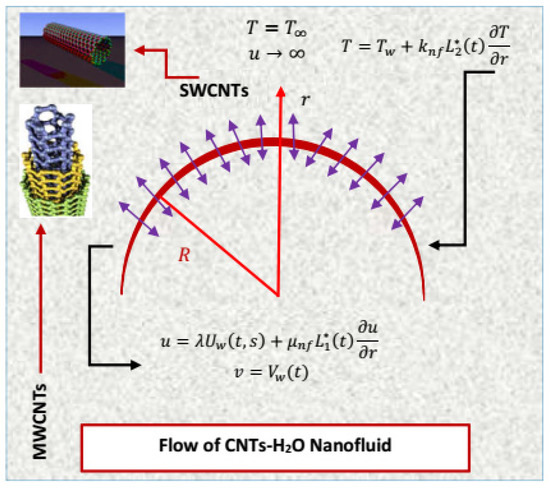
Figure 1.
Flow of CNTs-H2O colloidal suspension over curved stretching/shrinking surface.
2.1.2. Governing Model and Similarity Transformations
The following unsteady nondimensional flow model represents the nanofluid flow of CNTs-H2O over a curved surface [29].
The conditions at the surface and at the free surface are:
In Equation (6), the velocities Uw = as (1 − αt)−1, Vw = −aνf (1 − αt)−1S are s and t dependent, surface stretching and shrinking is represented by λ < 0 and λ > 0, respectively. The accelerated and decelerated flow situations depend on the value of α. The positive α shows the accelerating and negative α corresponds to decelerating flow situation. Further, suction or injection of the nanofluid denoted by S and L1* and L2* are the temperature jump and velocity slip parameters, respectively.
For nondimensionalization of the model, the following are defined similarities [29]:
2.1.3. Effective Nanofluid Models
To improve the thermophysical characteristics, the following models are utilized [20]:
where, is the density, heat capacitance, , dynamic viscosity, and is the effective thermal conductivity of the nanofluid. Further, , , are the density, dynamic viscosity, and thermal conductivity of the fluid phase and is thermal conductivity of the carbon nanotubes. The volume fraction is ϕ and the length and radius of the Carbon nanotubes (CNTs) are L and R, respectively. The thermal and physical characteristics of the fluid phase and carbon nanotubes are described in Table 1.

Table 1.
Thermophysical characteristics of CNTs and H2O.
2.1.4. Nondimensional Nanofluid Model
With the help of Equation (11), Equations (1)–(4) are transformed into the following model in the presence of length and radius of the carbon nanotubes incorporating in the energy equation:
The boundary conditions described in Equations (5) and (6) after the implementation of the similarity transformation reduced into the following version:
2.1.5. Significant Quantities from Engineering Aspects
The shear stresses and local Nusselt number can be defined by the formulas:
Here, the wall shear stress and the wall heat flux are denoted by τw and qw, respectively. These are as follows:
Finally, the self-similar form for shear stress and local heat transfer are obtained in the following way:
2.2. Mathematical Analysis
Consideration of SWCNTs-H2O and MWCNTs-H2O is a tedious, highly nonlinear, and coupled system of ODEs. In such situations, the analytical solutions are not reliable or do not even exist. Therefore, numerical techniques are better to tackle the model. Thus, the coupling of RK and shooting techniques ([14,15,30]) is adopted to capture the behavior of nanofluids flow regimes for multiple physical quantities. In ordered to initiate the algorithm, the following transformations are required depending upon the order of the self-similar momentum and energy equations described in Equations (12) and (13) along with boundary domains embedded in Equations (14) and (15). These transformations reduced the model into first order initial value problem which is then solved:
From Equation (19),
From Equations (19) and (20), we obtained;
In Equation (21), and are obtained by rearranging Equations (12) and (13) as below;
Or,
Now, the resultant initial value problem is attained by including the values from Equations (19) and (21) in Equations (22) and (24). Then, this was solved successfully by means of Mathematica software 10.0.
3. Physical Interpretation of the Results
3.1. The Velocity Distribution
This section describes the results for velocity, temperature, shear stresses, and local heat transfer rate by altering the parameters concealed in the velocity and energy equation. How the volume fraction affects the thermal and physical characteristics of the host fluid and carbon nanotubes is also explored. Furthermore, the impacts of the length and radius of the carbon nanotubes are investigated for the enhancement of thermal conductivity.
The behavior of velocity against suction S > 0 and stretching and shrinking of the surface (λ > 0 and λ < 0) are captured in Figure 2. It is perceived that the nanofluid velocity declines for a larger stretching parameter. Physically, larger stretching surface parameters produce more free space and the nanofluid particles are scattered at the surface therefore the velocity L’(η) drops. The decreasing behavior of MWCNTs-H2O is quite abrupt in comparison with SWCNTs-H2O. The reason behind these trends in the velocity are their densities. The nanofluid velocity asymptotically vanishes apart from the surface. On the other side, the velocity L’(η) enhances when the surface shrinks. Physically, when the surface shrinks then the curvature decreases and, consequently, the velocity increases. This behavior of the velocity L’(η) is shown in Figure 2a.
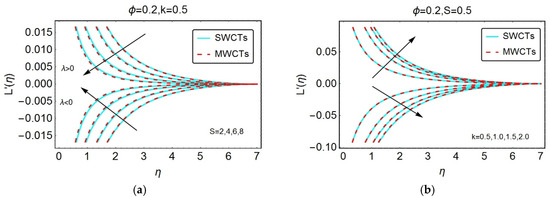
Figure 2.
The velocity behavior for (a) suction and (b) curvature parameters.
The influences of surface curvature on the nanofluid velocity are captured in Figure 2b. It is perceived that the nanofluid velocity L’(η) enhances for more stretching and larger curvature of the surface. Physically, the fluid particles adjacent to the surface drag when the surface stretches, therefore the velocity of the nanofluid increases. For smaller curvature, slow increment in the velocity behavior is captured. The velocity of SWCNTs-H2O and MWCNTs-H2O nanofluids asymptotically vanishes beyond η ≥ 4.0.
The velocity of SWCNTs-H2O and MWCNTs-H2O against λ1 for stretching and shrinking is painted in Figure 3. The reversal behavior of the velocity is examined for higher values of λ1. Further, it is noted that the nanofluid flows slowly for stretching while abrupt increasing trends are seen for the shrinking case. Asymptotic behavior of the velocity L’(η) is detected beyond η ≥ 5.0 for both SWCNTs-H2O and MWCNTs-H2O nanofluids.
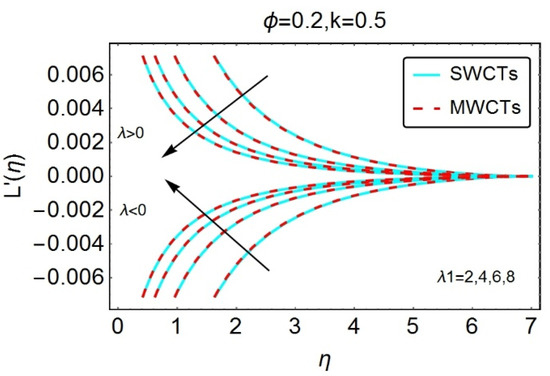
Figure 3.
The velocity behavior for velocity parameter .
3.2. Streamlines and Thermophysical Characteristics
The influence of parameters concealed in the streamlines pattern and the effective thermal conductivity for CNTs, effective density, and heat capacitance are incorporated in this subsection. The parameter α > 0 highlights the accelerated flow and decelerated flow corresponds to negative α.
Figure 4 portrays the flow pattern for accelerated and decelerated cases by keeping the surface curvature k = 4. In Figure 4a, the streamlines pattern is parabola opening downward over a curved surface. The flow is accelerated due to positive α. The streamlines expand at the free surface. It is investigated that there is no intersection of the streamlines which elaborates the phenomena of laminar flow. Figure 4b describes the flow pattern for the decelerated case. In the decelerated situation, the streamlines stretch towards a curved surface. The streamlines in the vicinity of the surface are exactly a parabolic shaped and far from the surface these become steeper. The streamlines behavior for larger surface curvature is depicted in Figure 5 for both accelerated and decelerated situations. The surface has the property of stretching which increases the surface curvature. Due to large curvature, the nanofluids flow over the surface along large curve which shrinks the streamlines pattern. An almost similar flow pattern is investigated for k = 8 in comparison with k = 4 for the decelerated case.
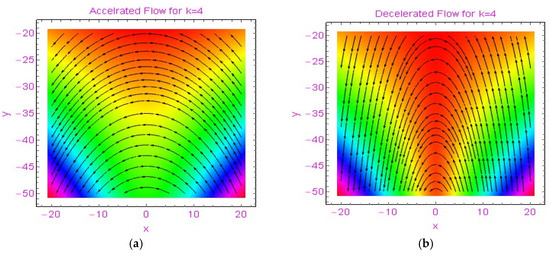
Figure 4.
Streamlines behavior for (a) accelerated, (b) decelerated flow situations when k-4.
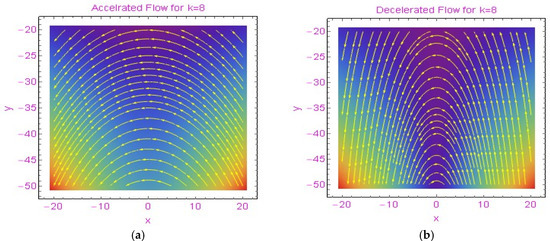
Figure 5.
Streamlines behavior for (a) accelerated and (b) decelerated flow situations when k = 8.
Figure 6 elucidates the impact of suction of nanofluid for accelerated and decelerated flow situations. Under the accelerated condition, the parabolic streamlines shrink towards x = 0. The nanofluid layers slide over one another rapidly. On the other side, for a decelerating nanofluid, the layers stretch rapidly in the locality of x = 0. Figure 7 elucidates the flow pattern for injecting nanofluids. By injecting the nanofluids, the streamlines open about x = 0. The streamlines stretch for the decelerated case quite rapidly in comparison with the accelerated case.
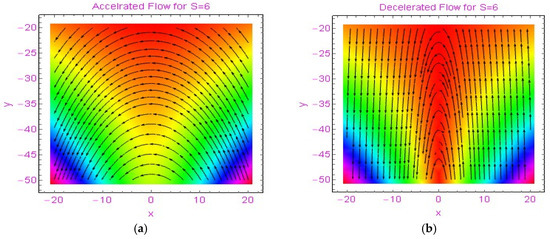
Figure 6.
Streamlines behavior for (a) accelerated and (b) decelerated flow situations when S = 6.
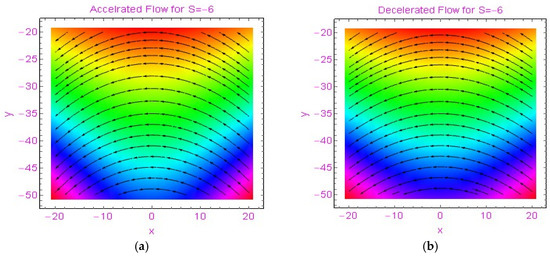
Figure 7.
Streamlines behavior for (a) accelerated and (b) decelerated flow situations when .
The impacts of length, radius, and volume fraction of CNTs on thermal conductivity of SWCNTs and MWCNTs are shown in Figure 8. High volume fraction of CNTs increases thermal conductivity of SWCNTs and MWCNTs. It is investigated that thermal conductivity for MWCNTs arises very rapidly in comparison with SWCNTs. The volume fraction ϕ is in direct proportion to thermal conductivity of CNTs. Like volume fraction, the length of the carbon nanotubes also favors the thermal conductivity for both types of carbon nanotubes. Less thermal conductivity is observed for a smaller length of carbon nanotubes. The radius of carbon nanotubes opposes the thermal conductivity. The carbon nanotubes having a larger diameter opposes the thermal conductivity. However, thermal conductivity of the carbon nanotubes can be enhanced for smaller diameters.
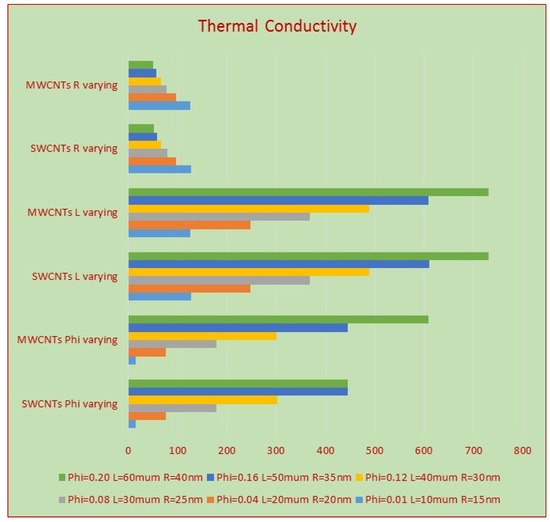
Figure 8.
The behavior of thermal conductivity of SWCNTs and MWCNTs for multiple volume fraction factor .
The volume fraction which has a central role in the study of nanofluids is very significant for heat capacity of the nanofluids. These influences are shown in Figure 9. For smaller values of ϕ, heat capacity rises very rapidly. The high-volume fraction opposes the effective heat capacity of the carbon nanotubes. The relation of ϕ and effective density of the carbon nanotubes is in direct proportion. The density of the carbon nanotubes increases for high volume fraction. These effects are elucidated in Figure 10.
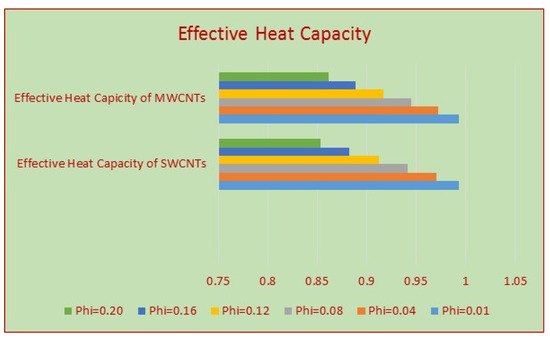
Figure 9.
The behavior of heat capacity of SWCNTs and MWCNTs for multiple volume fraction factor .
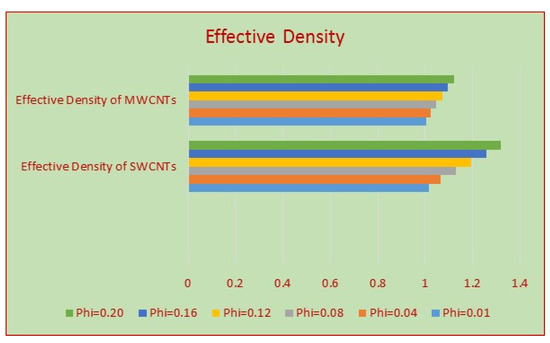
Figure 10.
The behavior of density of SWCNTs and MWCNTs for multiple volume fraction factor .
3.3. Local Heat Transfer Rate and Skin Friction
Local Nusselt number or simply local heat transfer rate and skin friction are important quantities from an industrial point of view. The significance of these quantities cannot be denied due to industrial usage.
Figure 11 depicts the heat transfer rate versus curvature, suction of the nanofluid, and stretching of the surface. The heat transfers at the surface drops for larger curvature and enhances for smaller curvature. For SWCNTs-H2O, nanofluid is better for more heat transfer. The larger impacts were inspected for suction of the nanofluid. For higher suction of the nanofluids, more fluid particles transfer at the surface which intensify the heat at the surface. The intensifications in the heat transfer are almost alike. The heat transfer and stretching (λ > 0) of the surface are in assisting condition. For a more stretched surface, there is a larger amount of the heat flow at the surface. The more escalations in the heat transfer were observed for the SWCNTs-H2O nanofluid.
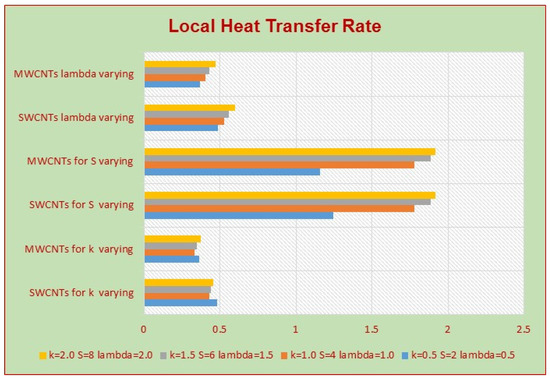
Figure 11.
The behavior local Nusselt number for multiple values of k, S, and .
The fluctuations in the shear stresses by altering curvature, suction of the nanofluids, and stretching parameters are elucidated in Figure 12. The shear stresses escalate for the less stretched surface. Higher stretching surfaces lead to drops in the shear stresses. Similarly, the skin friction drops for more suction. The variations in the skin friction for SWCNTs-H2O are rapid in comparison with the MWCNTs-H2O nanofluid. The curvature parameters and the friction are inversely proportional to each other. By decreasing the curvature of the surface, the skin friction escalated, and dominant behavior is observed for the SWCNTs-H2O nanofluid.
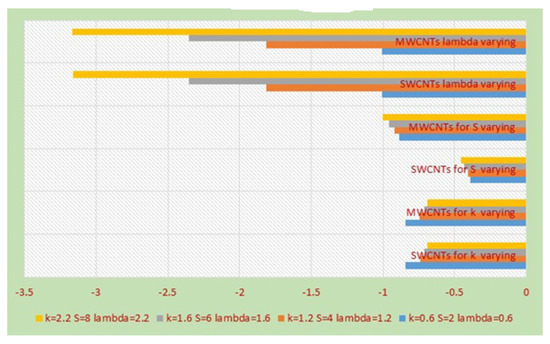
Figure 12.
The behavior of shear stresses for multiple values of k, S, and .
4. Conclusions
Thermal transport investigation in colloidal suspension of water suspended by carbon nanomaterials was examined over curved geometry. To improve the thermal transportation in the nanofluid, a thermal conductivity correlation comprising the effects of length and radius of carbon nanomaterials was plugged into the energy equation. Then, the colloidal model was treated numerically and captured the results for the velocity, local thermal transport, and shear stresses against multiple physical parameters. It was found that:
- The stretching of the surface provides more flowing area, due to which the nanofluid particles scattered at the surface and, consequently, the velocity of the nanofluids declines over the surface.
- The nanofluids flow abruptly over a shrinking surface and asymptotically vanish apart from the surface.
- The greater heat transfer rate at the surface is perceived for the suction and stretching/shrinking parameters.
- The decreasing trends in the shear stresses over the curved surface are examined for larger curvature, whereas they increase for the stretching/shrinking and suction parameters.
Author Contributions
U.K. and A. formulated the model, N.A. and T.A. tackled the model numerically, acquired funding, and revised the manuscript, and S.T.M.-D. and I.K. wrote the results and discussion. All authors have read and agreed to the published version of the manuscript.
Funding
This research received no external funding.
Conflicts of Interest
There is no conflict of interest regarding this publication.
Abbreviations
| L | length of carbon nanotubes |
| d | diameter of carbon nanotubes |
| CNT | carbon nanotubes |
| CuO | copper oxide |
| SWCNTs | single walled carbon nanotubes |
| MWCNTs | multi walls carbon nanotubes |
| ODEs | ordinary differential equations |
| RK | Runge–Kutta scheme |
References
- Maxwell, J.C.A. Treatise on Electricity and Magnetism; Clarendon Press: Oxford, UK, 1881. [Google Scholar]
- Choi, S. Enhancing Thermal Conductivity of Fluids with Nanoparticles in Developments and Applications of Non-Newtonians Flows. ASME 1995, 66, 99–105. [Google Scholar]
- Hamilton, H.L.; Crosser, O.K. Thermal Conductivity of Heterogeneous Two-Component Systems. Ind. Eng. Chem. Fundam. 1962, 1, 187–191. [Google Scholar] [CrossRef]
- Bruggeman, D.A.G. Berechnung verschiedener physikalischer konstanten von heterogenen substanzen, I—Dielektrizitatskonstanten und leitfahigkeiten der mischkorper aus isotropen substanzen. Ann. Phys. Leipz. 1935, 24, 636–679. [Google Scholar] [CrossRef]
- Wasp, E.J.; Kenny, J.P.; Gandhi, R.L. Solid–liquid flow slurry pipeline transportation. Trans Tech. Publ. 1977, 4. Available online: https://books.google.com.pk/books/about/Solid_liquid_flow_slurry_pipeline_transp.html?id=zO1SAAAAMAAJ&redir_esc=y. (accessed on 10 May 2020).
- Koo, J.; Kleinstreuer, C. A new thermal conductivity model for nanofluids. J. Nanopart. Res. 2004, 6, 577–588. [Google Scholar] [CrossRef]
- Koo, J.; Kleinstreuer, C. Laminar nanofluid flow in micro-heat sinks. Int. J. Heat Mass Transf. 2005, 48, 2652–2661. [Google Scholar] [CrossRef]
- Li, C.H.; Peterson, G.P. Experimental investigation of temperature and volume fraction variations on the effective thermal conductivity of nanoparticle suspensions (nanofluids). J. Appl. Phys. 2006, 99, 084314. [Google Scholar] [CrossRef]
- Patel, H.E.; Sundararajan, T.; Das, S.K. An experimental investigation into the thermal conductivity enhancement in oxide and metallic nanofluids. J. Nanopart. Res. 2010, 12, 1015–1031. [Google Scholar] [CrossRef]
- Godson, R.L.; Mohan, L.B.; Wongwises, D.S. Experimental investigation on the thermal conductivity and viscosity of silver—Deionized water nanofluid. Exp. Heat Transf. 2010, 23, 317–332. [Google Scholar] [CrossRef]
- Corcione, M. Rayleigh–Bénard convection heat transfer in nanoparticle suspensions. Int. J. Heat Fluid Flow 2011, 32, 65–77. [Google Scholar] [CrossRef]
- Sheikholeslami, M.; Li, Z.; Shamlooei, M. Nanofluid MHD natural convection through a porous complex shaped cavity considering thermal radiation. Phys. Lett. A 2018, 382, 1615–1632. [Google Scholar] [CrossRef]
- Sheikholeslami, M.; Zia, Q.M.Z.; Ellahi, R. Influence of Induced Magnetic Field on Free Convection of Nanofluid Considering Koo-Kleinstreuer-Li (KKL) Correlation. Appl. Sci. 2016, 6, 324. [Google Scholar] [CrossRef]
- Khan, U.; Adnan, A.N.; Mohyud-Din, S.T. 3D Squeezed Flow of γAl2O3-H2O and γAl2O3-C2H6O2 Nanofluids: A Numerical Study. Int. J. Hydrogen Energy 2017, 42, 24620–24633. [Google Scholar] [CrossRef]
- Ahmed, N.; Adnan, K.U.; Mohyud-Din, S.T. Influence of an Effective Prandtl number Model on Squeezed Flow of γAl2O3-H2O and γAl2O3-C2H6O2 Nanofluids. J. Mol. Liq. 2017, 238, 447–454. [Google Scholar] [CrossRef]
- Adnan, A.M.; Khan, U.; Ahmed, N.; Mohyud-Din, S.T. Analytical and Numerical Investigation of Thermal Radiation effects on Flow of viscous Incompressible fluid with Stretchable Convergent/divergent Channels. J. Mol. Liq. 2016, 224, 768–775. [Google Scholar] [CrossRef]
- Iijima, S. Helical microtubules of graphitic carbon. Nature 1991, 354, 56–58. [Google Scholar] [CrossRef]
- Yamada, E.; Ota, T. Effective Thermal conductivity of dispersed materials. Heat Mass Transf. 1980, 13, 27–37. [Google Scholar] [CrossRef]
- Xue, Q.Z. Model for Thermal conductivity of carbon nanotubes-based composites. Phys. Condens. Matter 2005, 17, 1655–1660. [Google Scholar] [CrossRef]
- Nadeem, S.; Khan, A.U.; Hussain, S.T. Model based study of SWCNT and MWCNT thermal conductivities effect on the heat transfer due to the oscillating wall conditions. Int. J. Hydrogen Energy 2017, 42, 28945–28957. [Google Scholar] [CrossRef]
- Ahmed, N.; Adnan, K.U.; Mohyud-Din, S.T. Influence of Thermal Radiation and viscous dissipation on squeezed flow of water between two Riga plates saturated with carbon nanotubes. Colloids Surf. A 2017, 522, 389–398. [Google Scholar] [CrossRef]
- Khan, U.; Ahmed, N.; Mohyud-Din, S.T. Heat transfer effects on carbon nanotubes suspended nanofluid flow in a channel with non-parallel walls under the effect of velocity slip boundary condition: A numerical study. Neural Comput. Appl. 2017, 28, 37–46. [Google Scholar] [CrossRef]
- Saba, F.; Ahmed, N.; Hussain, S.; Khan, U.; Mohyud-Din, S.T.; Darus, M. Thermal Analysis of Nanofluid Flow over a Curved Stretching Surface Suspended by Carbon Nanotubes with Internal Heat Generation. Appl. Sci. 2018, 8, 395. [Google Scholar] [CrossRef]
- Reddy, J.V.R.; Sugunamma, V.; Sandeep, N. Dual solutions for nanofluid flow past a curved surface with nonlinear radiation, Soret and Dufour effects. J. Phys. 2018, 1000, 012152. [Google Scholar] [CrossRef]
- Saleh, S.H.M.; Arifin, N.M.; Nazar, R.; Pop, I. Unsteady Micropolar Fluid over a Permeable Curved Stretching Shrinking Surface. Math. Probl. Eng. 2017, 2017, 1–13. [Google Scholar] [CrossRef]
- Wang, C.Y. The three-dimensional flow due to a stretching flat surface. Phys. Fluids 1984, 27, 1915–1917. [Google Scholar] [CrossRef]
- Wang, C.Y. Fluid flow due to a stretching cylinder. Phys. Fluids 1988, 31, 466–468. [Google Scholar] [CrossRef]
- Sakiadis, B.C. Boundary-layer behavior on continuous solid surfaces: I. Boundary-layer equations for two-dimensional and axisymmetric flow. AIChE J. 1961, 7, 26–28. [Google Scholar] [CrossRef]
- Nadeem, U.S.; Adnan, K.U. Stability analysis of Cu-H2O nanofluid over a curved stretching/shrinking sheet: Existence of dual solutions. Can. J. Phys. 2018, 97, 911–922. [Google Scholar] [CrossRef]
- Ahmed, N.; Khan, A.U.; Mohyud-Din, S.T. Unsteady Radiative Flow of Chemically reacting Fluid over a Convectively Heated Stretchable Surface with Cross-Diffusion Gradients. Int. J. Therm. Sci. 2017, 121, 182–191. [Google Scholar] [CrossRef]
© 2020 by the authors. Licensee MDPI, Basel, Switzerland. This article is an open access article distributed under the terms and conditions of the Creative Commons Attribution (CC BY) license (http://creativecommons.org/licenses/by/4.0/).